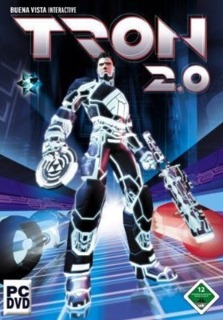Although relatively light on combat, T2.0 has some of the most appealing visual effects I've ever seen...
Tron 2.0 left me with that same feeling: despite the fact that I really enjoyed the game far, far, far more than its celluloid predecessor, I didn’t quite get my fill of all that it offered. T2.0’s sound and visuals are absolutely peerless among shooters, particularly the latter; as much as I relish wallowing in the mud of Hill 30 or barging down the metallic corridors of a UAC base, the neon bloom and see-through surfaces of T2.0 provided a rare and extremely welcome change of scenery. I’ve played through T2.0 three times since I bought it almost as many years ago, and the past two visits to each level in the game leave me just as enthralled as they did the first time. Blips and bars of data continuously stream across the gameworld’s vast “sky,” character animation is as detailed as one might expect from the wonderful Lithtech engine, and positively everything glows like electrified sherbet. If I had to list my favorite sections of T2.0, the stunning City Hub would take the top position, with the vertigo-inducing Firewall level next, Jet’s blue-hued commute aboard a repurposed Recognizer after that, and every other digital venue tied for the fourth spot. My praise for the dramatic evolution of the movie’s gleaming seams and solid RGB palette could never be effusive enough.
The concept of building the character of Jet – as well as his weapons, armor, and tools – was very well-realized in T2.0. Like any good role-playing setup, maximizing Jet’s stats in one category will sacrifice any added proficiencies to his other skills, so the player must weigh the benefits of more hit points against faster downloads for the game’s ubiquitous floating fireflies of data. I was obsessed with finding as many subroutines as possible and upgrading them all to their Gold version, particularly for Jet’s relatively underused arsenal. Therein lies my first gripe with the game: not enough combat. Although the Lithtech engine has never hosted the kind of pitched battles seen in Painkiller (with the exception of KISS: Psycho Circus), Jet’s trek across Thorne’s Outer Partition was one of the few sequences that contained a lot of down-and-dirty clashes. I could dispatch the isolated pairs and trios of ICPs and Z-Lots easily in nearly every other level with little more than my Disc Primitive. Don’t get me wrong: slinging the ol’ Frisbee was a whole lot of fun, but its Sequencer and Cluster upgrades were never really put to the test with so few targets around. The same sense of unrealized potential applies the other Primitive groups, particularly the Mesh. In fact, I was very careful not to waste any Code Optimization Ware upgrades on subroutines for which I might later uncover a better version (I even used Der Schnitter’s handy per-level map of Alpha/Beta/Gold downloads on my most recent playthrough), but I never managed to perfect the Prankster Bit supergun. Of course, I never really needed that weapon, anyway, since it appeared far too late in the game and boiled down to a bit of overkill when used against the sparse opposition.
Tron 2.0 is one of those unfortunate titles – like its cousin NOLF, XIII, Tribes: Vengeance, and the woefully truncated SiN renaissance -- of which the publisher didn’t sell enough copies to warrant the development of additional episodes -- with the exception of the Archer-free blip that was Contract JACK -- despite (or likely because of) their unique appeal. I would gladly return to the inner space of the Bradley family’s digital domain for more grid battles and stimulating sights as long as Monolith managed to mix in more action.

